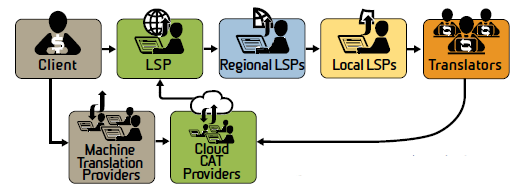
Imagine connecting all the elements of life, from the Creator to the dust of the earth, in a single hierarchical structure. That’s what classical and medieval philosophers sought to do. They termed it“The Great Chain of Being.” This idea dominated scientific and theological thinking for centuries. However, as method-based scientific investigation along with new paradigms of structuring nature began to revolutionize knowledge in the Renaissance and Enlightenment, the Great Chain of Being became little more than a historical curiosity. Yet this redundancy does not mean that it has been cast aside and completely forgotten. This idea is still widely investigated by scholars of the history of ideas in their attempt to understand the past and how it influenced subsequent developments.
想象一下,从创世者到地球的每一粒微尘,将所有生命元素都连接在一个层级结构中。这正是古典哲学家与中世纪哲学家试图实现的状态。他们将其称为“存在之链”。几百年来,这一理念始终主宰着科学和神学思维。但是,文艺复兴与启蒙运动时期,随着基于方法的科学考察以及自然构造新范式开始推动知识革命,“存在之链”逐渐沦为一种历史求知欲。虽然现在看来这种理论显得多余,但并不意味着已经被彻底摒弃和遗忘。观念史学者们仍然在对这一理念开展广泛的研究,试图了解过去以及这种理念对发展所产生的影响。
In the language industry, I would argue that we are undergoing a similar transformation in our understanding of how to transform source texts into myriad targets on a bewildering variety of subjects in a heterogeneous communications environment. In our case, the chain we use to describe the links between language professionals and end users is termed the supply chain. This is a commonly used business term and is key in helping us organize our activities efficiently in terms of costs and time.
我认为语言服务行业也正在经历类似的变革,即如何在异构通信环境中,将源文本转换为各种主题的无数目标文本。对于我们来说,我们用于描述语言专家和用户之间的链接就是所谓的供应链。供应链是一个常用的商业术语,它在帮助我们从成本和时间角度高效组织活动方面的作用非常关键。
The advent of the supply chain in business seems to have been motivated by the desire to model processes in such a way as to facilitate smooth production of goods and services. It also served to identify all elements that were necessary for those processes to be structured efficiently with cost-effectiveness a prime motivating factor. A point we can learn from this is that the elements in a supply chain have always been there,but modeling them endows linkage, a structure where, if you like, causes and effects are explicitly understood.
商业领域之所以会出现供应链,似乎是出于对某种流程模型的需要,该模型促进货物和服务的顺利生产。这种模型还可用于识别所有必要元素,确保以有效且经济的方式来构建这些流程,成本效率也是主要的推动因素之一。我们需要知道的是,供应链中的元素始终存在,但是通过创建模型能够在各个元素之间建立联系,继而透过这一结构更清楚地理解各个元素之间的前因后果。
Except that’s not exactly the way the language industry’s supply chain works. The truth known to all language professionals is that the supply chain in our industry is fragmented and actually is prejudicial to the interests of the organizations that provide services like translation, localization and so on to the ultimate buyers.
然而,语言服务行业供应链的运作方式不尽相同。我们行业内的供应链呈两端分离的片段式,事实上这一现状会使那些为最终买家提供诸如翻译、本地化等服务的组织利益受损,这是整个语言行业内专业人士所周知的事实。
In the language community, our supply chain models have had drastic changes in very short periods of time. The chain of supply used to be simple and obvious. A client’s requirement and a translator’s work embodied a straightforward one-to one relationship. Of course, there were complications from time to time, but the list of parameters involved was minimal. Nothing ever stays the same! Client requirements have mushroomed. Technology has proliferated at an unimaginable speed. The world has shrunk. Our community has responded with the advent of localization, internationalization and globalization. And now we’re theorizing about heading off planet! What’s next, universalization?
对语言服务行业来说,我们的供应链模型在极短的时间内发生了巨大的变化。过去的供应链相对简单而且明确,客户的要求和译员的工作表现为直接的一对一关系。当然,复杂一些的情况也时有发生,但其中涉及的参数种类少之又少。任何事物都不是一成不变的!客户的要求与日俱增...技术飞速发展超乎想象...世界已今非昔比。为应对这种巨变,我们经历了本地化、国际化和全球化。眼下,我们正探索驶离地球的无限可能!那么接下来会是什么,宇宙化?
Well, whatever the Musks and Bezoses of this world are planning, we’d better be prepared because as things stand, the language industry’s supply chain has not evolved in accordance with the aforementioned industry developments. Language services are one of the more recent business sectors to benefit from the wealth of tools and techniques of business analysis. Just a few decades ago, translation was mostly provided by freelance translators. International publishing houses, academia and only a few businesses like language learning were exceptions. In recent decades, the entire multilingual landscape has undergone massive seismic shifts. As language service providers (LSPs) have responded to the changing requirements of the business community, new ways of analyzing how language services can meet those requirements have emerged. One of those is in modeling a supply chain in which all the intricacies of supply and demand are met. But how successful have these models been? The answer is, so-so. A number of factors are preventing that answer from being an unqualified yes.
好吧,无论这个世界上的马斯克们(自动驾驶)和贝佐斯们(电商行业)正计划着什么,我们都需要做好更充分的准备。因为,就现状来看,语言服务行业的供应链显然还没有跟上上述行业的发展步伐。语言服务是一个相对而言较新兴的商业部门,它的发展得益于丰富的商业分析工具和技术。就在几十年前,大部分的翻译工作还都是由自由译员完成。一些国际出版公司、学术机构和类似于语言学习机构的少数企业属于例外情况。近几十年来,整个多语言环境经历了巨大的变化。语言服务提供商 (LSP) 努力应对商业企业不断变化的要求,关于语言服务如何满足这些要求的全新分析方法也应运而生。其中之一就是创建一种供应链模型,通过这一模型满足供需之间错综复杂的关系。但是这些模型到底获得了多大的成功?答案是,不过如此。多种因素导致我们无法给出一个令人满意的回答。
There is no single model of the language industry supply chain. In fact, those devised so far lie between the very simple and the very complex. The simplest model describes the process of a language supplier meeting the demand of a plain translation requirement. One source; one target (Figure 1).
对于语言服务行业来说,并不存在一种通用的供应链模型。事实上,目前提出的各种模型都介于非常简单和非常复杂两个极端之间。最简单的模型描述了语言服务提供商为了满足普通翻译要求而实施的流程。一个来源;一个目标(图 1)。

Figure 1: A simple supply chain.
图 1:简单供应链。
Increase the parameters of those elements, introduce language technology, factor in cultural aspects, quality control, peer review, financial constraints and so on and simplicity yields to complexity. One of the developments that characterized the translation and localization industry during the last couple of decades was consolidation. From at least a dozen large vendors, we are currently down to a handful, publicly trading or with full financial backing. Consolidation also manifested itself in the emergence of a relatively standard production outsourcing model. The larger vendors took on multilanguage, multiservice projects, outsourcing the core translation services to single language vendors, one in each target country. Tese smaller local LSPs normally work from one or more source languages into one target language only, and either work with onsite translators or contractors.
增加元素参数、引入语言技术、文化影响、质量控制、同行评审、财务制约因素等等...使模型从简单变得复杂。过去几十年里,翻译和本地化行业最显著的发展之一就是合并:从至少十几家大规模的服务提供商,到现在少量的公开交易或拥有足够资金支持的供应商。随着相对标准的生产外包模型的出现,合并现象越来越明显。大型供应商承接多语言、多元服务项目,而核心的翻译任务通常外包给单语言供应商(例如,在每个目标语言国家选择一家供应商)。这些当地较小规模的语言服务提供商 (LSP) 负责将一种或多种源语言翻译成同一种目标语,翻译工作通常由内部译员或签约的翻译提供方完成。

Figure 2: A longer chain means distance between clients and translators.
图 2:供应链越长就意味着客户与译员之间的距离越远。
This particular enlargement of the supply chain has resulted in the translators being extremely removed from the client (Figure 2). This fragmentation of the language industry is problematic because it creates division between clients (demand) and translators (supply). The consequence of this is that information that should be freely flowing from the client to the translator is blocked or simply lost in the large chain. The LSPs have used this block as a means to devalue the service of the translator as being easily replaceable should the need arise. The freelance translator as an individual doing business is no match for the LSP, which as an organization is able to meet the clients’ demands and invest in similar automation.
延长供应链导致译员与客户间隔两端,相距甚远(图 2)。语言服务行业供应链的片段式是存在问题的,它造成了客户(需求)与译员(供应)之间的分离。由此导致的结果就是本应从客户处顺畅传达至译员的信息受到阻隔,或者完全淹没在层层链条中。语言服务提供商 (LSP) 利用这种片段阻隔状态降低译员服务的市场价格。“客户需求”不再指定由某个译员完成,任何译员都能够被轻松取代。自由译员以个人身份开展业务活动,其能力根本无法与语言服务提供商 (LSP) 匹敌,后者作为组织机构能够满足不同的客户需求并投资应用自动化技术。
Because of this ability of the large LSPs to match client investment in automation, the language industry operates with an asymmetrical supply chain. The automation and localization efforts of large corporate ventures have resulted in very sophisticated technology to power translation using MT and translation memories, in turn managed with version control and project management software tools. Yet the rendering of source language into target translation is still performed by highly-trained translation professionals. Somehow the requirements of the demand end of the chain are disproportionate to the supply end. Asymmetry exists, disrupting efficiency (Figure 3).
鉴于大型语言服务提供商 (LSP) 具备根据客户要求投资应用自动化技术的能力,语言服务行业的运作形成了一种两端不对称的供应链。大型创投企业通过在自动化和本地化方面的努力,开发出了非常复杂的技术:利用机器翻译 (MT) 和翻译记忆库实现强大的翻译能力,通过版本控制和项目管理软件工具对机器翻译 (MT) 和记忆库进行管理;而将源语转换为目标语的翻译任务仍然由经过专业培训的翻译专业人士完成。就这样,供应链的需求端与供应端比重失衡。不对称现象的存在扰乱了效率(图 3)。

Figure 3: Adding tech to the long supply chain.
图 3:在长供应链中加入技术。
It seems clear, therefore, that tech alone is not the solution to the problem. What is required is a means of strengthening on an equal basis the links in the supply chain, thus providing full recognition of all of those contributing to its functions.
显然,光靠技术并无法彻底解决问题。我们需要的是一种能够在平等的基础上强化供应链中各元素间链接的方法,从而全面认识有助于实现供应链功能的所有元素。
The financial burden of licenses and the constant pressure to upgrade software is a perennial source of pain for freelancers. It’s also a headache for companies, especially huge corporations, where spending on software may be subject to restrictions stipulated by procurement. Full stack tools are myriad these days and you can’t use every one on offer.
不断升级软件、支付许可证费用...带来的经济负担和压力是自由译员长期面临的痛苦来源。这一点对于公司来说也十分头疼,尤其是那些软件支出需要严格遵循采购规定的大型企业。现如今,市场上有着各种各样的全栈工具,你不可能每一种工具都用到。
Businesses these days are driven by market forces that massively enlarge their operations, and with that comes increasing complexity. As a consequence, any modeling activity must try to capture structures that resist depiction as stable, slow-changing entities. Perhaps business management software tools can help, but dynamic situations are not always predictable. The localization community is a perfect example of this conundrum. The development of CAT tools, industry standards like XML and now some increasingly efficient machine translation apps have greatly improved the likelihood of sophisticated client requirements with ever-shortening delivery dates and reduced costs. But this just increases asymmetry between LSPs and the language professionals who actually do the work. Enterprises are not much inclined to speak about this and so the situation prevails. The real truth is that technology alone cannot supply and meet all translation requirements. Thankfully, however, this is now being brought out into the open as the supply chain is increasingly shown to be fragmented.
而企业在当前市场力量的推动下,大幅扩大各自的经营规模,继而致使经营的复杂性不断提高。因此,建模活动需尽可能捕获避免实体稳定和变化缓慢的结构。也许,业务管理软件工具能够提供帮助,但是动态情境并不总是可以预测的。本地化行业就是这种难题的一个绝佳示例。CAT 工具、诸如 XML 之类的行业标准以及现在一些效率不断提升的机器翻译 app 的开发为满足复杂的客户要求、不断缩短的交稿时间和降低成本等各方面目标提供了更多可能,也使语言服务提供商 (LSP) 与那些实际从事翻译工作的语言专业人士之间的不对称性进一步加剧。尽管企业大都讳莫如深,而这一现象逐渐变得屡见不鲜。光靠技术并无法供应和满足所有翻译要求,这是不争的事实。所幸的是,随着语言服务行业供应链两端分离现象的日益明显,行业已经开始公开讨论这一问题。
Language professionals themselves also must shoulder some responsibility for this state of affairs. The language community is made up of many different skill sets and each of these harbors a range of experience by which individuals qualify as translation providers or not. Inexperienced and new translators often find themselves in a supporting role to the experienced and successful providers whose services are in demand by LSPs. This inequality is difficult to overcome and with the pressure mounting for ever-increasing volumes of translations in ever-increasing language pairs, the supply chain’s links are under even more strain.
语言专业人士本身也需要对这一事态负有一定的责任。语言社群由大量不同的技能集组成,其中每种技能集都需要积累丰富的经验,而这些技能集也是衡量个人是否具备作为翻译提供者资格的标准。缺乏经验的新译员们通常只能作为资深、成功的翻译提供者的助手,而语言服务提供商 (LSP) 对于这种资深翻译求贤若渴。这种不平等是难以消除的,加之不断增多的语言对和翻译量,供应链内各元素间的链接也在承受越来越大的压力。
This is a complicated and tortuously involved situation. Corporate enterprises urgently need to reexamine the status of the language community and elevate it to a much higher prominence in their globally-driven structures. LSPs and sundry consultants need to understand that the days of using translation professionals as irrelevant are distant history. Educators need to forge new links and share their work to elevate the level of experience new graduates bring to the job market. The supply chain needs to be reforged in order to accommodate new and burgeoning technology, skilled users and innovative enterprises across the globe. We all need to keep reminding ourselves of our multilingual status and to cast off the hegemonies that resulted in this highly imperfect business environment. We should be ambitious in attempting to modify our business cultures to reflect more closely the cultures we find in this amazingly diverse world. The challenge is there, so what are we waiting for?
这是一种错综复杂的现象。企业非常迫切地想要重新审视语言社群的状态,并将其在各自全球化结构中的重要性提升到更高的水平。语言服务提供商 (LSP) 和各类顾问需要知道,认为翻译专业人士无关紧要的时代已成为遥远的历史。教育者们需要打造新的链接,分享各自的成果,提升应届毕业生进入职场时的经验水平。我们需要重新打造供应链,使其适应迅速发展的新技术、满足熟练用户和创新型企业的需求。我们需要不断提醒自己的多语言身份,摆脱造成这种高度缺陷的商业环境的行业影响。我们应踌躇满志,努力去改变当前的商业文化,使其与我们所在的这个多元世界的文化一起熠熠生辉。挑战已经出现,你还在等什么呢?
节选自Jeannette Stewart——The links of the language supply chain